The Right Coat: Balancing Respect and Comfort at Funerals
When attending a funeral, choosing the right coats for funerals is essential for showing respect while ensuring your comfort during the service. Here's what you need to know:
- Traditional colors: Black, navy, and charcoal are most appropriate (80% of mourners choose these colors)
- Length: For dresses/skirts, coat should be at least as long as the garment underneath
- Material: Wool or wool-blend for winter; lightweight fabrics for summer
- Style: Conservative overcoats, trench coats, or custom coats are ideal
- Indoor etiquette: Plan to remove your coat during indoor services
Selecting appropriate funeral attire demonstrates respect for the deceased and provides comfort during what can be an emotionally challenging time. The right coat serves both practical and symbolic purposes, especially for outdoor graveside services where temperatures can drop significantly.
I'm Mortuary Cooler, with over a decade of experience advising funeral directors on professional presentation including appropriate coats for funerals for staff and mourners alike. My work with American Mortuary Coolers has given me unique insights into funeral industry standards across various regions and traditions.
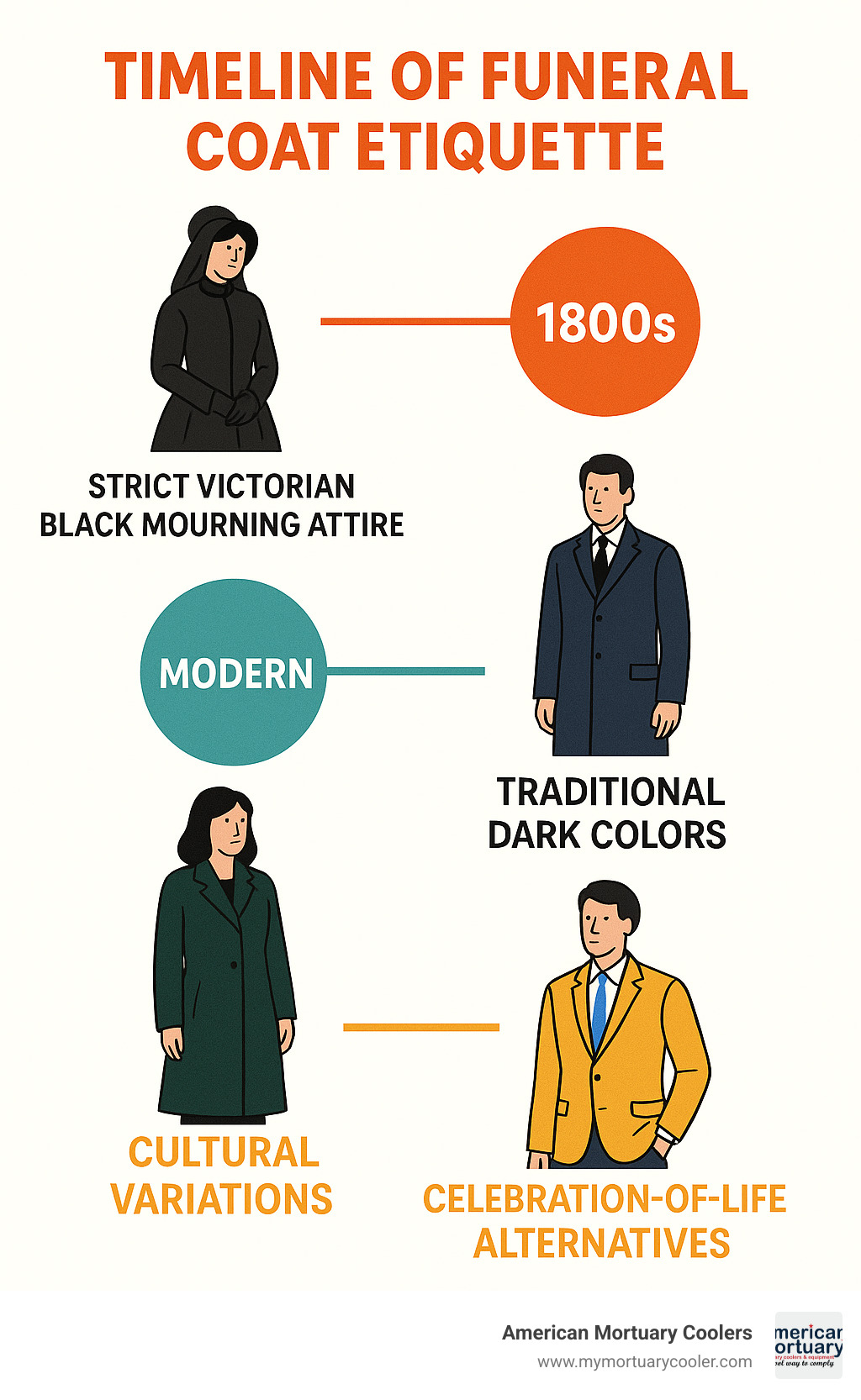
Coats for funerals terms to learn:
Why Wearing the Right Coat Matters at a Funeral
What you wear to a funeral says a lot—sometimes even before you get a chance to speak. The coat you choose doesn’t just keep you warm; it quietly shows your respect, signals dignity, and helps set the tone as soon as you arrive. When it comes to coats for funerals, that outer layer is your first handshake, your first gesture of empathy.
Funeral professionals often say: Your presence is what matters most, but your outerwear does the talking before you do. The right coat creates a supportive environment for grieving families. There’s comfort in seeing others dressed with care, in colors and styles that say, “I’m here with you.”
The facts back this up. Over 70% of mourners prefer longer coats for funerals, especially for outdoor services. This isn’t just a style preference. Longer coats offer more coverage during graveside ceremonies, which can run 20–30 minutes and sometimes feel even longer when weather isn’t on your side.
At American Mortuary Coolers, we see this firsthand. Whether you’re in Tennessee or out on the Pacific Coast, families and professionals alike balance tradition with practical needs. Layering and choosing the right outerwear matter, both for comfort and appearance. It’s about respecting tradition without sacrificing your own wellbeing.
Scientific research on how dress affects our mindset shows that formal clothing—especially at a funeral—helps foster a sense of seriousness and unity. When everyone comes together in respectful attire, the mood is set before a single word is spoken.
Coats for Funerals and Emotional Support
There’s more to coats for funerals than fabric and buttons. Outerwear is a silent language. Think of Queen Victoria, whose iconic black mourning dress set a visual tone that still lingers today. While we aren’t as strict now, our coat choices still send a signal: “We honor your loss.”
When a crowd gathers in dark coats, it brings a sense of togetherness. As one Chicago funeral director shared, seeing a sea of respectful outerwear is like the community giving a group hug to the grieving family. It’s visual solidarity—simple, subtle, but powerful.
Health & Safety During Outdoor Services
Of course, funerals aren’t always indoors. Outdoor graveside services can mean cold winds, rain, or biting temperatures. This is when coats for funerals become more than tradition—they’re essential for your health.
Funeral homes and experts recommend a science-backed approach to keeping warm: layering. Start with a moisture-wicking base (like polyester, wool, or silk), add an insulating middle layer (think sweater or vest), and top it off with a protective funeral coat. This system traps heat better than a single bulky coat, so you can adjust between outdoor chill and indoor warmth.
Sometimes, warmth is more important than style. One attendee shared, “When I buried my Grandfather in August, all I cared about was not freezing.” The right coat isn’t just about looking good—it’s about looking out for yourself and those around you.
For added health and safety, especially for vulnerable guests, consider the latest Covid-19 PPE options if needed.
Whether you’re honoring tradition, supporting others, or just trying to stay warm, coats for funerals play a bigger role than many realize. They help you show up fully, in every sense—present, comfortable, and respectfully dressed.
Appropriate Coat Styles for Traditional Services
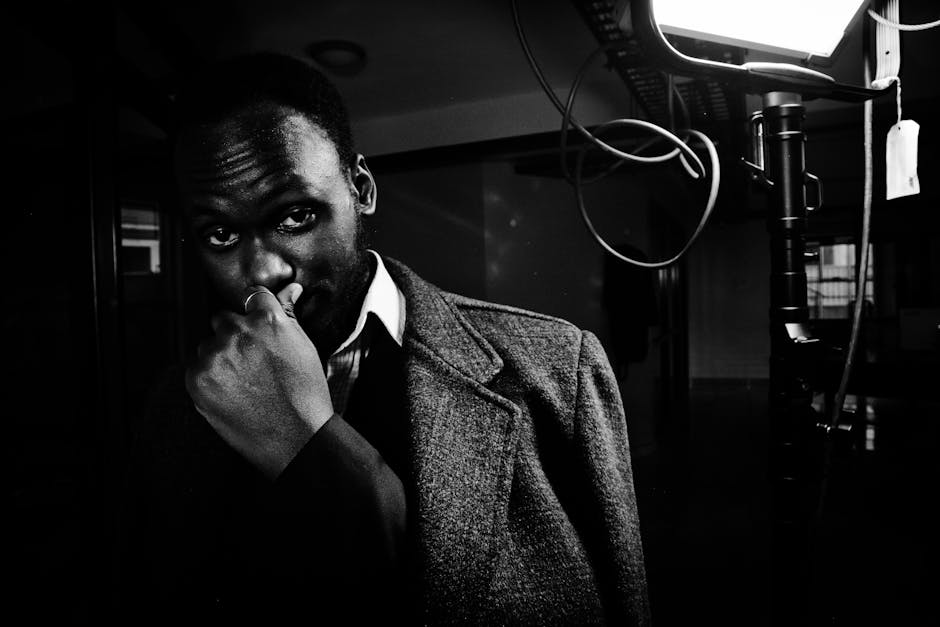
When it comes to coats for funerals, sticking with time-tested, classic styles will always serve you well. The right coat doesn’t just keep you warm; it helps you blend in respectfully, offers a sense of comfort, and quietly supports the dignity of the day. Let’s walk through the traditional options that never go out of style.
Coats for Funerals: Men's Choices
For men, a classic overcoat in black, charcoal, or navy is the gold standard. Look for one that’s knee-length or longer. This style—whether single- or double-breasted—works seamlessly over a suit without feeling bulky. If you want something a touch more formal, the Chesterfield coat is a strong choice, thanks to its velvet collar and smooth, straight lines.
In many parts of the US and UK, funeral directors and pallbearers often wear a black tailcoat. This is traditional, and over 90% of funeral professionals stick to this tried-and-true look. While you likely don’t need a tailcoat for most funerals, it’s helpful to know what the staff will be wearing.
If the weather looks dreary, a dark trench coat is practical and perfectly acceptable. Just keep it simple—fasten the belt and make sure the fit is neat. No need to reinvent the wheel; a well-fitted coat, with shoulders lining up just right and sleeves hitting just past your wrists, quietly signals respect without stealing the spotlight.
A senior funeral director from our Atlanta team puts it best: “A coat shouldn’t distract. It should feel comfortable and look cared for. That’s all most families are hoping for, really.”
Coats for Funerals: Women's Choices
For women, there’s a little more room for personal preference while still honoring tradition. The wrap coat is a wonderful choice—comfortable and flattering, and the belt gives a pulled-together look. A-line wool coats are another classic, pairing well with dresses and skirts. The key here: your coat should match or fall below your dress hem, keeping your look neat and warm.
A belted trench coat—in black or navy—offers both style and practicality, especially if rain is in the forecast. If you prefer something softer on the shoulders, a cape coat lets you layer underneath and move comfortably. According to online polls, more than 70% of folks suggest that your coat should be at least as long as your dress or skirt, for both warmth and a seamless visual line.
Examples from Funeral Directors & Staff
In the funeral profession, staff outerwear sets the tone for the whole service. We work with funeral professionals all across the country at American Mortuary Coolers, and certain standards hold steady. Black tailcoats with striped trousers remain the formal pick for directors, while simple black or charcoal overcoats are staples for outdoor services. In places where tradition is less strict, you might spot a navy overcoat in the mix.
One director summed it up: “My overcoat is my invisible handshake. It says I’m here to do this job with care, and I’ll be warm enough to do it well.”
Companies like Lyn Oakes specialize in professional funeral wear, adding thoughtful touches like deep pockets for essentials and reinforced seams for durability—small details, but they matter when you’re standing outside for long stretches.
No matter your role or your budget, coats for funerals don’t have to be flashy or expensive—they just need to show that you care enough to get it right. And if you need help finding a suitable coat, you’re not alone; plenty of suppliers and second-hand options can help you find something respectful, warm, and comfortable.
Color Expectations, Fabrics & Formality
Choosing the right color and fabric for your funeral coat speaks volumes about your understanding of the occasion. In Western cultures, tradition still holds strong—over 80% of mourners reach for coats for funerals in black, navy, or charcoal, continuing centuries-old mourning traditions that date back to Victorian times.
Your coat's formality should match the service type. For traditional ceremonies, you'll want to select structured wool or cashmere coats in darker shades. If you're attending a more contemporary celebration of life, you might have a bit more flexibility with color and style, though maintaining a respectful appearance remains essential.
"The fabric of your coat communicates your respect for the occasion," explains a funeral etiquette consultant we work with at American Mortuary Coolers. "Natural fibers like wool not only provide better temperature regulation but also carry an inherent dignity that synthetic alternatives often lack."
When it comes to selecting materials, you're balancing practical needs with ceremonial appropriateness. Wool offers excellent warmth while maintaining a formal appearance suitable for traditional services. Cashmere provides supreme comfort and warmth but comes at a higher price point. Wool-synthetic blends offer practicality and versatility, while technical fabrics might be necessary for extreme weather conditions but sacrifice some formality. Melton wool, with its dense weave, provides exceptional warmth and weather resistance for winter services.
| Fabric | Warmth Rating | Formality Level | Best For | Sustainability |
|---|---|---|---|---|
| Wool | ★★★★☆ | ★★★★★ | Traditional services | High (natural, biodegradable) |
| Cashmere | ★★★★★ | ★★★★★ | Formal services | Medium (natural but resource-intensive) |
| Wool-Synthetic Blend | ★★★☆☆ | ★★★★☆ | Versatile use | Medium (partially natural) |
| Technical Fabric | ★★★★☆ | ★★☆☆☆ | Extreme weather | Low-Medium (depends on recycled content) |
| Melton | ★★★★★ | ★★★★☆ | Winter services | High (dense, durable wool) |
When Black Isn't Required: Acceptable Alternatives
While black remains the classic choice for coats for funerals, it's not always mandatory. In fact, UK funeral statistics show that requests for non-traditional funeral attire, including colored coats, have increased by 25% over the past decade.
If you're considering alternatives to black, several options maintain appropriate dignity while offering a softer approach. Deep navy provides nearly the same level of formality as black but with a slightly less severe appearance. Charcoal gray offers a gentler alternative that still conveys proper respect. In some regions, deep forest green or burgundy may be acceptable, particularly for celebrations of life rather than traditional services.
"Always prioritize the family's wishes," advises our funeral coordinator in Dallas. "If they've specified a theme or color scheme, that takes precedence over general traditions. When in doubt, contact someone close to the family to clarify expectations."
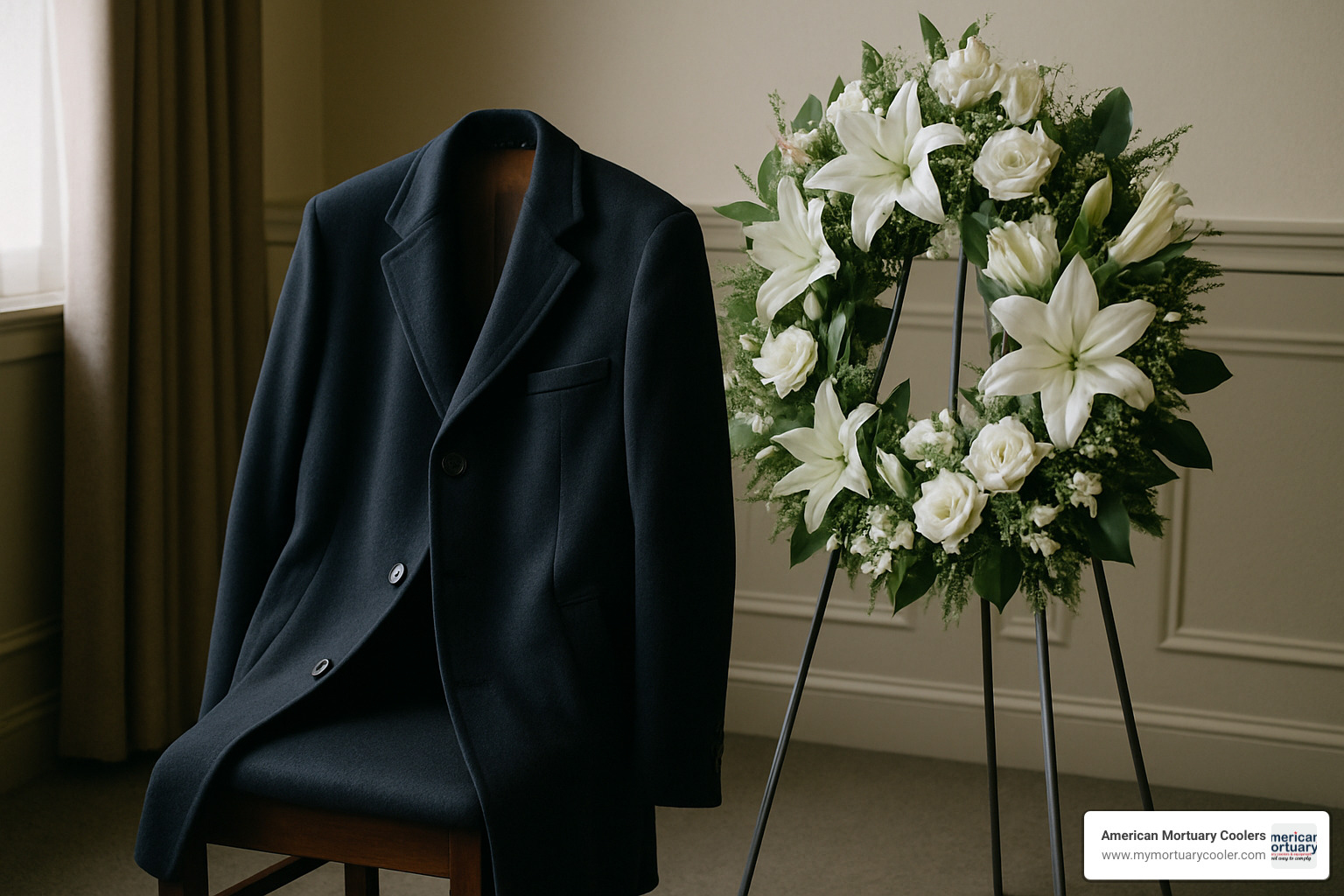
Cultural backgrounds significantly influence color expectations. If you're attending a Hindu or some Sikh funerals, you might be surprised to learn that white is the traditional mourning color. In South Africa and Ghana, red may be appropriate for funeral attire. Purple serves as a mourning color in Thailand and Brazil. Understanding these cultural variations helps us show respect in the most appropriate way for the deceased and their family.
Materials That Balance Warmth & Respect
Finding coats for funerals that keep you warm without compromising on respect isn't always easy, but several materials excel at this balance.
Wool-cashmere blends offer the best of both worlds—the structure and formality of wool with the added softness and warmth of cashmere. These blends maintain their shape beautifully while providing excellent insulation against cold weather.
For a modern approach, consider wool coats with technical linings. These give you the classic, dignified appearance of traditional wool on the outside while incorporating modern technology on the inside for superior warmth.
If sustainability matters to you, look into recycled polyester blends. These newer fabrics can provide good water resistance and warmth while reducing environmental impact—an increasingly important consideration for many families.
For those winter services in particularly cold regions, melton wool offers exceptional protection. This densely woven, weather-resistant wool stands up to harsh conditions without sacrificing the formal appearance expected at a funeral service.
At American Mortuary Coolers, we've seen how important appropriate attire is for maintaining dignity during services. Our teams in colder regions like Chicago and the Northeast particularly emphasize finding that perfect balance between weatherproof protection and formal appearance, especially during challenging winter ceremonies.
Seasonal & Weather-Specific Guidance
Funerals don’t pause for the weather—they happen in every season, rain or shine. That’s why choosing the right coats for funerals is about more than just tradition: it’s about respect, comfort, and being prepared for whatever nature brings on the day.
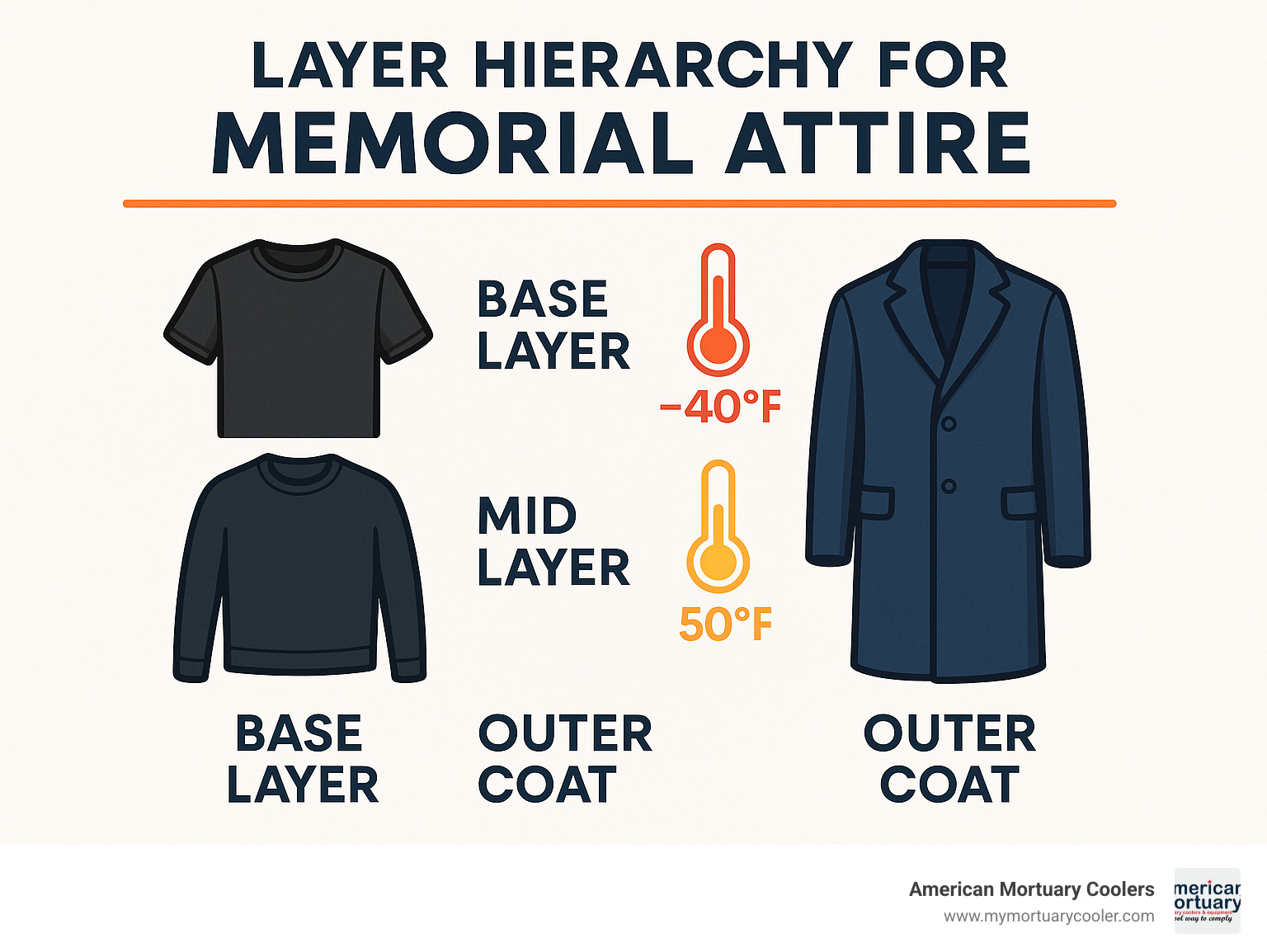
Deep-Winter Coats for Funerals
Winter funerals, especially those with outdoor portions, call for extra planning. Cold winds at the graveside can catch even the most seasoned mourner off guard. The best coats for funerals in the cold are insulated wool overcoats—think long, lined, and designed to keep out every chilly gust. Styles with thinsulate or down interlining are ideal, delivering warmth without looking bulky.
Full-length overcoats that extend well below the knee are much more than a style choice—they’re practical. Temperatures at outdoor services are often much lower than indoors, so a longer coat offers essential coverage. Traditional details like storm cuffs (those hidden snug cuffs inside the sleeve), high collars, and hidden plackets help seal out the wind while keeping your look polished.
As one of our Midwest funeral directors likes to say: “It’s hard to focus on honoring a loved one if you’re shivering. Warmth isn’t just comfort—it’s kindness to yourself and others.”
Don’t forget your accessories. Dark gloves, scarves, and hats—kept in simple, muted colors—add warmth and look respectful. Just be sure nothing overshadows the occasion. Aim for subtle coordination, not a fashion show.
Rainy-Day & Transitional Season Picks
Spring and fall bring unpredictable forecasts. One minute the sun is shining, the next there’s a downpour. This is when a waterproof trench coat or a lightweight wool coat with a water-resistant finish really shines. These coats handle light rain without sacrificing dignity. Styles with vented backs help if you’re standing for a long time, allowing some airflow.
If you’re someone who always seems to attract the raincloud, consider tucking a packable dark raincoat into your tote or car. It’s easy to slip on if the skies open up, and it won’t clash with funeral attire. (And who wants to spend a service fussing with a giant umbrella or dripping wet sleeves?)
Layering is still your best friend in these seasons. A lighter wool coat with a removable liner works perfectly for those days when it feels like three seasons in one afternoon. If you need shoe protection, choose dark, weather-appropriate footwear, and keep flashy rain boots at home.
Hot-Climate & Indoor-Only Services
When the heat is on—or the entire service is indoors—the last thing anyone wants is to be sweating through a heavy overcoat. For warm-weather funerals, it’s fine to swap out traditional heavy coats for lighter, respectful alternatives.
Men might turn to a dark blazer or a linen-blend jacket in black, navy, or charcoal. These still look formal but won’t leave you overheating. For women, a structured cardigan, shawl, or light wrap works well, especially over sleeveless dresses. Tropical-weight wool is another smart pick—it’s designed for breathability and keeps its shape, even in summer heat.
As our Pacific Region team notes, “It’s about looking put-together without being distracted by discomfort. The focus should always be on honoring the person, not on your sweaty back!”
No matter the weather, the main goal is respect—for the family, for the person being remembered, and for yourself. By planning ahead and choosing the right coats for funerals, you’ll be able to stay comfortable and present, come snow, rain, or summer sun.
If you’re ever in doubt, reach out to the funeral home or look for any dress code guidance in the service invitation. And if you’d like more practical advice on funeral planning details—like coordinating sympathy flowers or staying eco-friendly—you can always find more expert resources here and here.
Matching Your Coat to the Rest of Your Outfit
Coordinating your coats for funerals with the rest of your outfit shows care, thoughtfulness, and respect for the service. When your coat fits with your overall look, you appear calm, collected, and supportive—a quiet comfort to grieving families.
For women, coat length is the detail most people notice. A good rule to follow: your coat should be at least as long as your dress or skirt, never shorter. This keeps everything tidy and modest, even if you find yourself outside in the wind or rain. Most mourners agree—over 70% in online forums say matching coat and dress or skirt length is a must for funeral attire.
Men should make sure their coats for funerals fit smoothly over a suit jacket without bunching at the shoulders or looking too tight. The coat collar should rest flat against your suit, giving clean lines from neck to hem. You want to look polished, but not stiff or uncomfortable.
Accessories matter, too. While it’s not about matching every single item, you want your choices to blend together without drawing attention away from the occasion. For men, a solid or subtle dark tie is best. Women might choose a small, structured bag in a dark color. Everyone should opt for polished, conservative shoes—no bright sneakers or flashy heels today.
A style consultant we work with likes to put it this way: “Coordination isn’t sameness. It’s making sure nothing shouts for attention and every piece feels intentional.” In our experience at American Mortuary Coolers, funeral professionals often build a dedicated wardrobe just for these moments—a few well-chosen coats, shoes, and accessories that always come together respectfully.
Want to add a thoughtful detail? If you’re bringing flowers, consider how the colors and style coordinate with your outfit. For tips, you can read our guide on styling sympathy flowers.
Children's Funeral Coats
Dressing children for funerals can be a delicate balance. You want them to look respectful, but comfort is the top priority—especially for little ones who may not sit still for long. Dark pea coats are a classic solution for both boys and girls: soft, warm, and never fussy. For older kids, a plain school blazer works well, especially for indoor services. Some parents choose simple, dark overcoats—basically, smaller versions of adult coats without flashy buttons or bright logos.
Fabrics should be soft and non-itchy, so children can focus on being present rather than fussing with their clothes. No one expects perfect formality from toddlers, and most families are just happy to have children included.
As one Pittsburgh funeral director reminds us: “It’s more important to show up together than to stress over tiny dress code details. Simple, comfy, dark outerwear is just right.” And if a child’s coat has a safety reflector or cozy lining, even better—funerals can be long and sometimes chilly.
Personalisation & Themed Funerals
Funerals are changing. More families now ask mourners to add a personal touch to their coats for funerals—a gentle way to reflect the personality or passions of the person being remembered. In the UK, for example, one in four services now features non-traditional attire or color themes.
Personalization doesn’t have to be bold. A discreet embroidered symbol or date on the inside of a lapel can carry deep meaning. Some people fasten a meaningful lapel pin—maybe a small military insignia, a favorite hobby, or a charity ribbon. In celebration-of-life services, a colorful scarf, tie, or pocket square can honor the loved one’s favorite color.
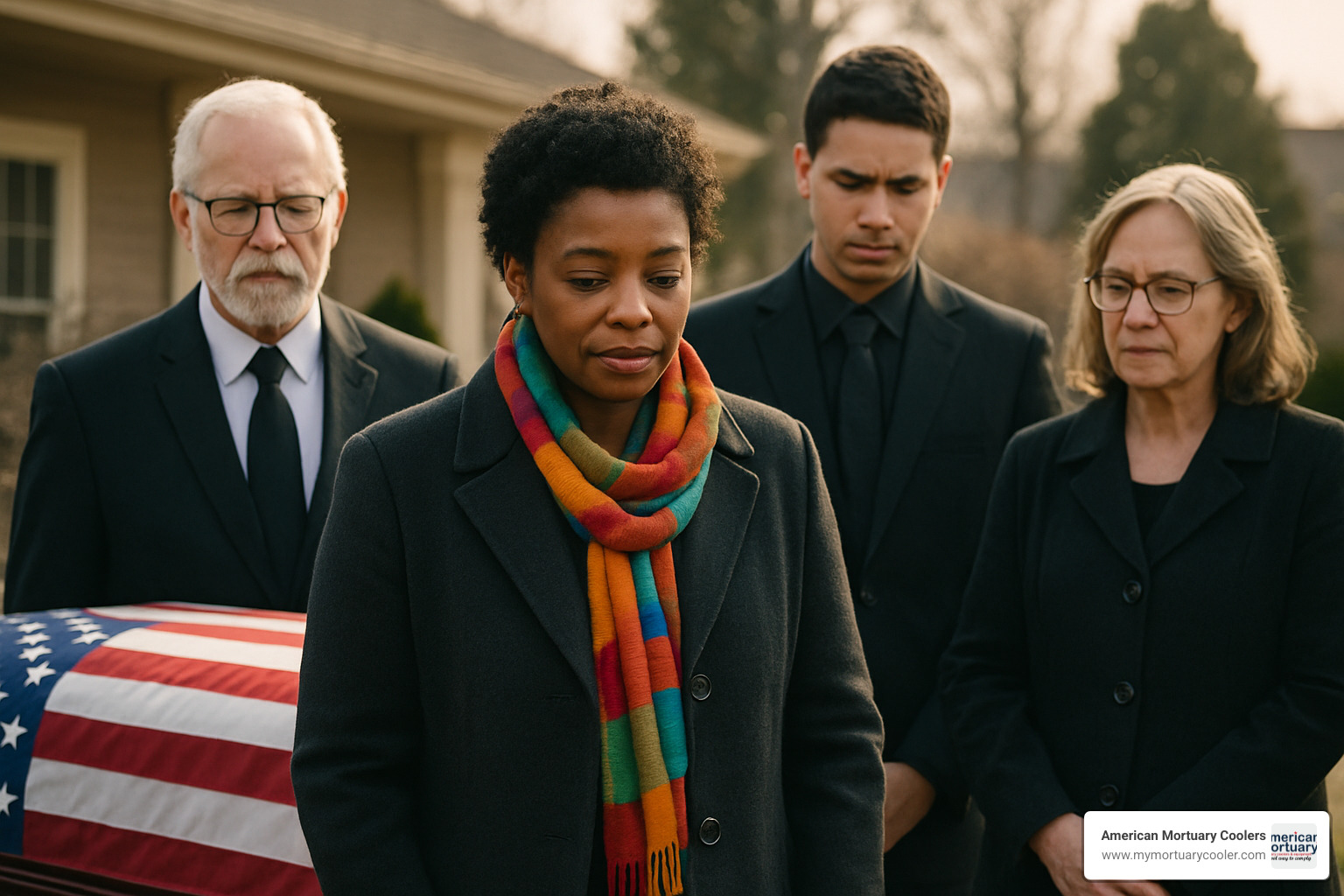
Sometimes, families request themed attire. Maybe it’s sports team colors or sunflower pins for someone who adored gardening. We once saw a service where everyone wore dark coats with a small, cheerful sunflower—proof that tradition and personality can exist side by side.
If you’re unsure how much personalization is welcome, it’s always best to ask the family or check the invitation. When in doubt, subtle touches are safest.
No matter what, the heart of your outfit should always be care and respect. Whether you’re in traditional black wool or a navy coat with a colorful scarf, what matters most is your presence and the support you bring to those who need it.
Cultural & Regional Variations to Know
When it comes to funeral attire, what's appropriate in one culture might be completely unexpected in another. Understanding these variations isn't just about following rules—it's about showing genuine respect in a way that resonates with the deceased's community and traditions.
In Western traditions, particularly those with British influence, dark colors remain the standard for coats for funerals. However, step outside this tradition and you'll find a beautiful diversity of mourning attire:
In Japan, black formal wear dominates funeral services, but there are subtle variations depending on your relationship to the deceased. A close family member's attire differs slightly from that of a colleague or distant friend.
Hindu and many Sikh funerals traditionally feature white clothing as the color of mourning—a stark contrast to Western black. If attending such a service, a tasteful white coat would be appropriate and appreciated.
Caribbean funeral traditions often accept vibrant colors that celebrate the deceased's life rather than focusing solely on loss. These joyful celebrations honor the person's spirit in a way that can feel surprising but deeply meaningful to those accustomed to more somber services.
"When I attended my first Thai funeral, I was surprised to see purple incorporated into mourning attire," shares one of our consultants who works with our international clients. "It taught me that what we consider 'universal' funeral etiquette is actually quite culturally specific."
Even within countries, regional differences emerge. Rural American funerals typically maintain a more relaxed dress code than their urban counterparts. British services often adhere more strictly to traditional mourning attire than many American ceremonies, where "celebration of life" events have gained popularity.
The rise of eco-funerals brings another consideration—some may specify biodegradable materials only. Before attending such a service, it's worth checking whether traditional synthetic-blend coats are acceptable or if natural fibers are preferred.
Etiquette for Removing or Keeping Your Coat On
One of the most common questions we hear at American Mortuary Coolers concerns when to keep your coat on and when to remove it during services. While working with funeral homes across the country, from our Tennessee headquarters to California, we've gathered some helpful guidelines:
When arriving at a service, keep your coats for funerals on, particularly if there's an outdoor procession or receiving line. This presents a complete, respectful appearance as you greet the family.
For indoor services in well-heated venues, remove your coat once seated. Fold it neatly on your lap or place it under your seat if space allows. However, if the building is poorly heated or you're seated in a drafty area (common in some historic chapels), keeping your coat on is perfectly acceptable.
Pallbearers face special considerations. Tradition suggests removing your coat during your duties unless weather conditions are severe. This small sacrifice demonstrates respect through slight personal discomfort, though modern funeral directors increasingly prioritize practicality in extreme weather.
"I always tell families that the general principle is balancing respect with practical comfort," explains a funeral director from our Johnson City headquarters. "No one benefits from mourners who are distracted by extreme discomfort, but minor discomfort in service of respectful appearance shows your commitment to honoring the deceased."
For graveside services, keep your coat on, neatly buttoned or fastened. These outdoor ceremonies often feel colder than expected due to standing still for extended periods, even on seemingly mild days.
When in doubt about protocol at a specific venue, simply follow the lead of the funeral directors or immediate family members. They'll typically signal appropriate moments for removing outerwear, either explicitly or through their own actions.
Buying, Renting & Budget-Friendly Options
Getting the right coats for funerals doesn’t have to break the bank—or leave you scrambling. Whether you attend funerals often or it’s your first time needing formal outerwear, there are plenty of ways to find something respectful, warm, and affordable.
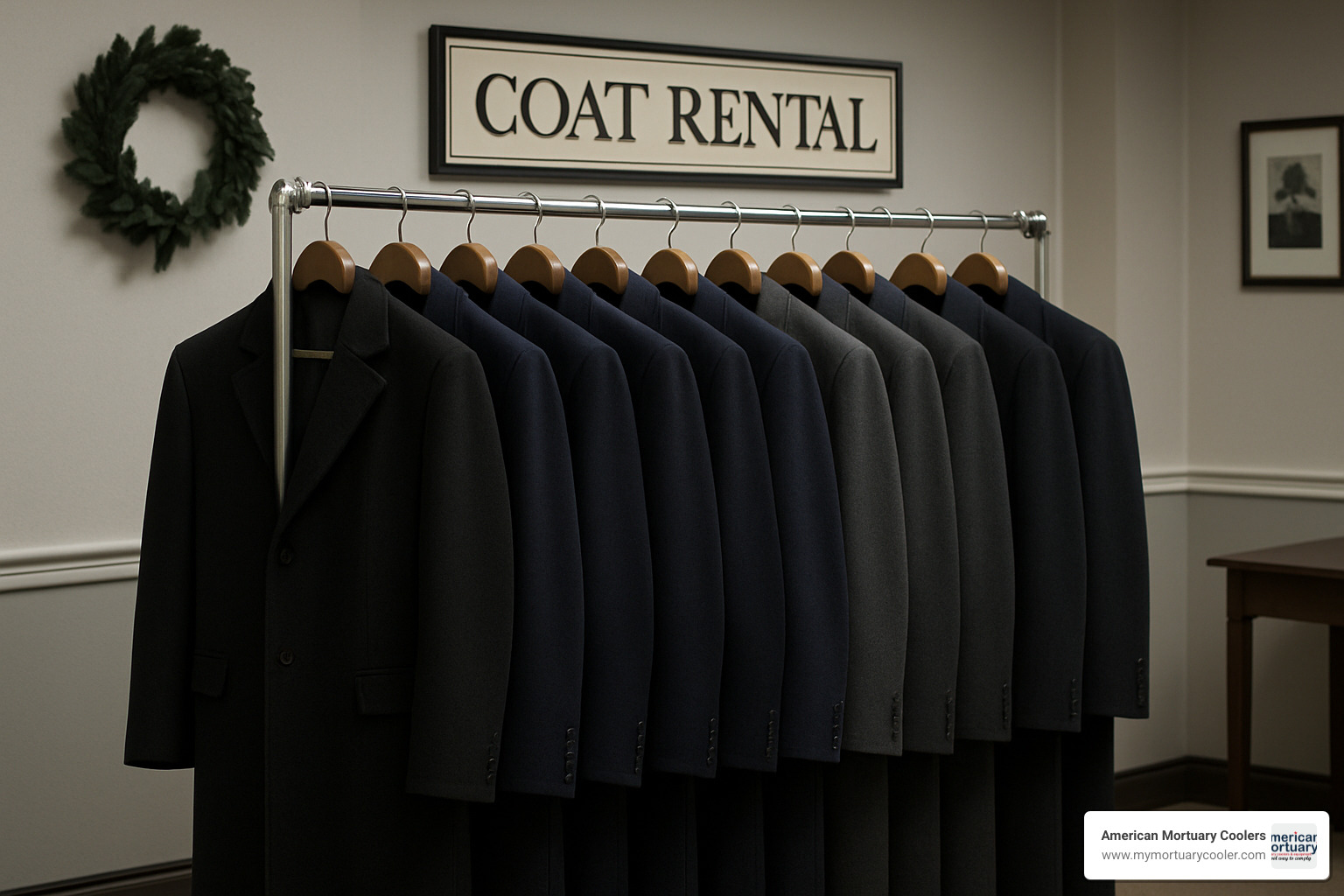
Where to Shop or Hire Quickly
If you’re in a time crunch, don’t worry—finding an appropriate coat can be straightforward. Department stores like Macy’s, Nordstrom, and JCPenney usually have a good selection of dark-colored overcoats and trench coats year-round, especially in cooler months. If you don’t plan to wear it often, check out formal wear rental shops. These places, known for tuxedos, often carry classic overcoats too—perfect for a one-time need.
For a wallet-friendly option, look into ex-hire specialists like Tweedmans. They sell gently used funeral wear, including quality coats, at a fraction of the original price. And if you’re really in a hurry, many online retailers offer fast shipping on formal coats—just double-check delivery dates before you click “Buy.”
Regional quirks can help, too. In the Northeast, older formalwear shops tend to keep a stash of rental coats for just these moments. In the Midwest, local thrift shops and vintage stores are hidden gems for sturdy wool coats at bargain prices. Down South, department stores usually stock lighter dark coats—no one wants to sweat through a Tennessee summer funeral in heavy wool!
If you’re ever unsure, our team at American Mortuary Coolers is happy to recommend local shops in your area. It’s all about finding what works quickly, so you can focus on the day itself.
Caring for Your Funeral Coat Post-Service
Once your funeral coat has served its purpose, a little care goes a long way. Let your coat air out before storing it, especially if the day was long or the weather unpredictable. Gently brush away dust and lint—it only takes a minute but helps keep fabric looking sharp.
If you opted for wool or cashmere, send it to the dry cleaner once a year, or after any big event. Mention that it’s formal wear, so the cleaner handles it with care. When storing, hang your coat on a padded or wooden hanger to keep its shape, and toss in a cedar block or a lavender sachet to keep moths away (unless you’re fond of tiny, hungry tenants).
A classic dark overcoat isn’t just for funerals—it transitions well to work, formal events, or winter Sundays at church. If you find you no longer need it, consider donating it to a local charity. Many organizations will happily pass it along to someone who needs formal wear for job interviews or special events.
As our Northeast Region representative says, “A good wool coat is an investment in dignity and warmth. With just a little love, it can last you—and maybe someone else—a lifetime.”
For those focused on the environment or planning a green service, look for second-hand options or eco-friendly materials. Curious about more sustainable choices? Read more about eco-friendly funerals here.
No matter your budget or timeline, there’s a way to find coats for funerals that show respect, keep you comfortable, and fit your needs.
Frequently Asked Questions about Funeral Coats
Do I have to wear a black coat?
Black has long been the traditional choice for coats for funerals in Western cultures, but it's not an absolute requirement. Dark navy, charcoal gray, and other deep neutrals have become widely accepted alternatives for funeral services.
Most mourners—about 80% according to our observations—still choose black, navy, or charcoal outerwear for traditional services. This is changing, though, especially for celebrations of life where families often welcome more personalized expressions of sympathy.
"I always tell people that honoring the family's wishes comes first," says Maria, one of our cultural consultants who works with funeral homes across Tennessee. "If they've specifically requested certain colors or themes, that guidance should take priority over general traditions."
If you're uncertain about what's appropriate, black remains the safest choice. That said, don't feel pressured to purchase a new coat if you already own a dark, formal alternative in navy or charcoal. The respect you show by attending is far more important than having the perfect shade of outerwear.
What length should my coat be if I'm wearing a dress?
When wearing a dress or skirt to a funeral, your coat should ideally be at least as long as your hemline—and preferably longer. This creates a balanced, respectful silhouette while ensuring appropriate coverage during outdoor portions of the service.
In our conversations with funeral attendees, most women (over 70%) recommend choosing a coat that matches or exceeds their dress length. This guidance serves both practical and aesthetic purposes. A coat shorter than your dress not only exposes the fabric to potentially harsh weather but can create a visually disjointed appearance that might distract from the solemnity of the occasion.
"For knee-length dresses, I find that a coat reaching mid-calf creates the most harmonious look," shares Rebecca, a style consultant who works with several funeral homes in our network. "If you're wearing a tea-length or maxi dress, you'll want to look for a full-length coat to match."
Don't have a coat of the right length? Consider borrowing one from a friend or family member rather than wearing something significantly shorter than your dress. The effort shows your attention to detail and respect for the occasion.
Can I keep my puffer jacket on during a graveside service?
While traditional wool overcoats remain the gold standard for coats for funerals, real-world weather sometimes demands practical alternatives. During extremely cold graveside services, a dark, understated puffer jacket is certainly preferable to risking your health or being visibly uncomfortable throughout the ceremony.
If winter weather necessitates wearing a puffer jacket, you can make it more appropriate by choosing the darkest, most subdued version available—preferably in black, navy, or dark gray. Look for styles with minimal shine and no visible branding. Make sure it's clean and in good condition, and consider adding a dark scarf to create a more formal appearance.
"Living in the Rockies, we see all kinds of practical adaptations to funeral attire during winter," explains James, who coordinates our services in mountain regions. "When it's below freezing at a graveside service, what matters most is that you're present to support the family, even if your coat isn't perfectly traditional."
For indoor portions of the service, try to remove your puffer jacket if possible, especially when seated. If you're attending both indoor and outdoor components of a winter funeral, layering is your friend—a dark sweater or blazer underneath your puffer can help you transition appropriately between settings.
Showing up to support grieving friends and family is what truly matters, even if weather conditions require some practical adjustments to traditional funeral attire.
Conclusion
Choosing the right coats for funerals is about finding that sweet spot between honoring traditions and meeting practical needs. While this guide offers plenty of guidance, your presence and emotional support for the grieving family matter far more than having the perfect outfit.
Here at American Mortuary Coolers, we've seen how funeral services blend ceremonial traditions with real-world practicalities. Our teams—from our home base in Johnson City, Tennessee, to our staff in New York, Chicago, Dallas, and beyond—have gained a deep appreciation for both respecting time-honored customs and making sensible adaptations when needed.
If there's one thing to take away from this guide, it's that dark, conservative coats remain the gold standard for traditional services. Pay attention to how your coat's length and fit create an overall impression of respect and thoughtfulness. Don't ignore the weather forecast—it's perfectly reasonable to prioritize staying warm and dry during outdoor services. And always be mindful of cultural differences that might influence what's considered appropriate attire.
When uncertainty strikes about what to wear, there's a simple solution—reach out to someone close to the family and ask about their expectations. This small gesture shows you care enough to get it right.
At the end of the day, what truly matters isn't having flawless funeral attire but showing up with a sincere heart to support those who are grieving. Your thoughtfully chosen coat is just one way to visibly demonstrate that support.
For our funeral industry colleagues, we at American Mortuary Coolers remain dedicated to supporting your important work. Just as you help families steer difficult times with dignity and care, we're committed to providing you with reliable, custom equipment that meets the highest standards of quality and respect—delivered directly to your door anywhere in the contiguous 48 states.
















